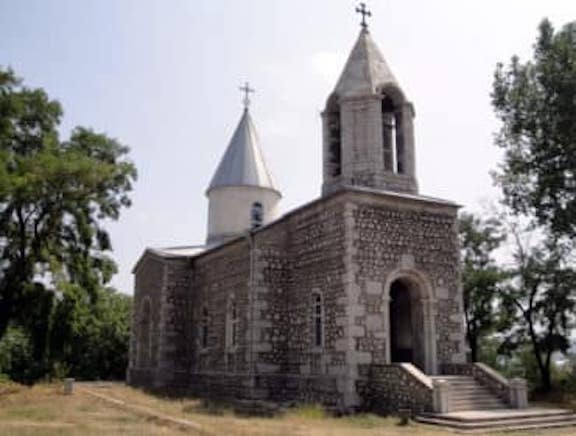By Asbarez | Thursday, 18 March 2021

After visiting a 17th century church in occupied Hadrut, Azeri President Ilham Aliyev ordered the removal of medieval inscriptions, calling them “fake” (Video screenshot)
Azerbaijan’s President Ilham Aliyev ordered the removal of medieval Armenian inscriptions from Armenian Churches that have fallen under Azerbaijani control, calling them “fake.” In a separate incident, Azerbaijani forces currently occupying Shushi have destroyed the St. John the Baptist church, commonly known as “Kanach Zham” leveling it to the ground.
Aliyev issued the order to his entourage when visiting Hadrut with his wife and Azerbaijan’s Vice-President Mehriban Aliyeva this week, angering official Stepanakert and Yerevan, which condemned the Azerbaijani leader for advancing “cultural terrorism.”
“Such official visits are nothing but a manifestation of anti-Armenian and militaristic policy of Azerbaijan and an insight into its future aggressive plans,” said the Artsakh Foreign Ministry in a statement it publicized on Thursday.
“The Republic of Artsakh has alerted the international community on numerous occasions about Azerbaijan’s state-orchestrated cultural terrorism, its efforts to erase Armenian cultural heritage in territories that are under its military occupation further advancing its genocidal expansionist policy,” said the Artsakh Foreign Ministry.
“This genocidal policy is a crime against humanity, a gross violation of international norms, conventions, resolutions and agreements, and a threat to the entire civilized world,” added the ministry. “We call on the relevant international organizations to take all the necessary measures to prevent the eradication of Armenian cultural heritage as well as to resolutely condemn the genocidal policy of Azerbaijan. Inaction and indifference are fraught with unpredictable consequences.”

The St. John the Baptist Church–or Kanach Zham–in Shushi was destroyed by Azerbaijani forces after the war ended
Artsakh’s Foreign Minister David Babayan called the destruction of Kanach Zham “cultural genocide,” adding that the “actions by Azerbaijan against Armenian historical-cultural monuments is the continuation and the manifestation of their fascist policy in a disgusting and dangerous manner.”
“Azerbaijanis know our history very well and the destruction of that Church is nothing but a message from the Azerbaijani president and the state that they will do the same if they are able to take control of all of Artsakh,” added Babayan.
“Such actions of Azerbaijanis in no way differ from the actions of terrorists in the Middle East, who destroyed universal monuments,’’Babayan said, adding that the only difference is that if in the Middle East some terrorist groups are responsible for the atrocities, in the case of Azerbaijanis those actions are state-sponsored.

Aerial images show the Kanach Zham Church in October and later in February completely destroyed
Calling Azerbaijani blatant destruction of heritage a contempt for international law, Babayan said “the civilized world should take measures, because if today they are destroying Artsakh’s cultural heritage, the international community’s indifference may resulting in them knocking on their doors tomorrow.”
Armenia’s Foreign Minister on Thursday called on the international community, particularly UNESCO, to intervene to save the monuments in Azerbaijani-occupied territories of Artsakh that have not yet been destroyed.
“During the Azerbaijani occupation of the Hadrut region, the once prosperous settlements with tens of thousands of Armenian inhabitants were completely annihilated, and many civilians were killed. The international community, including the UN High Commissioner for Human Rights and Human Rights Watch, have expressed their clear position regarding the cases of blatant violation of the Geneva Convention in the Hadrut region, when captured civilians were subjected to extrajudicial execution,” the Foreign Ministry said in a statement. It added that Aliyev’s statements in Hadrut reveal an intention to destroy Armenian settlements and replace them with the Azerbaijani ones, which violates the provisions of the trilateral statement of November 9, 2020, according to which the displaced people must return to their places of residence. It also proves that the Armenians of Artsakh cannot survive under the Azerbaijani control.
The ministry warned that under its policy of ethnic cleansing, Azerbaijan is taking consistent steps aimed at eliminating and appropriating the Armenian cultural heritage of Artsakh.
The Armenian Foreign Ministry said the destruction of Kanach Zham occurred months after the end of military actions in Karabakh.
“The concerns that the Armenian side has been expressing since the very first days the Armenian historical-cultural monuments fell under the Azerbaijani control, are materializing. These facts demonstrate that Azerbaijan’s assurances that it will preserve the Christian historical-cultural heritage and is willing to cooperate with UNESCO are completely false,” said the ministry. “Under the current situation, the timely intervention of the international community, particularly UNESCO, to save the monuments that have not yet been destroyed becomes urgent.”
“There cannot be solid and lasting ‘peace’ built on the basis of destruction of the peaceful settlements of Artsakh, its historical-cultural heritage, annihilation of the Armenian population and the replacement of the Armenian settlement with the Azerbaijani ones. We will continue our struggle for a just and dignified peace by working closely with our international partners,” the ministry concluded.
comments
A Nation Betrayed, A Future to Reclaim: Why Unity is Our Only Path Forward at the 2026 Elections
Armenia Has Become Largest Buyer of Indian Weapons
ARF AU Statement: In solidarity with Tavush
OPED: The Beginning of a New Struggle
Already Scarce Bread to be Rationed in Artsakh Due to Blockade
Artsakh Political Factions Agree On New President
Pashinyan Warns International Community of New Azerbaijani Attacks Against Armenia, Artsakh
Artsakh Students, Kidnapped by Azerbaijan, Released into Armenian Custody
Artsakh Says Azerbaijan’s Demands Further Complicate Situation